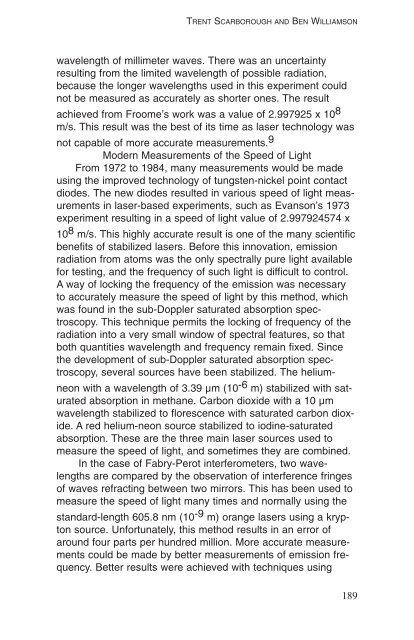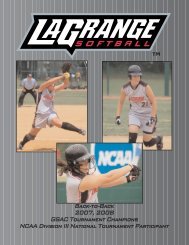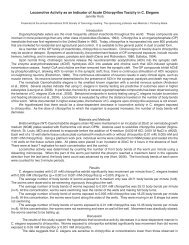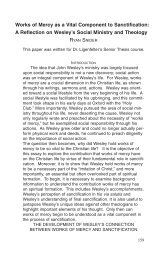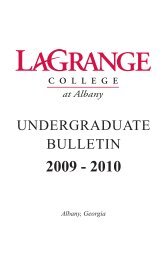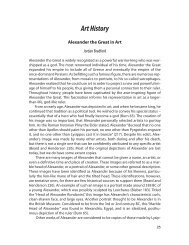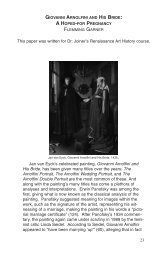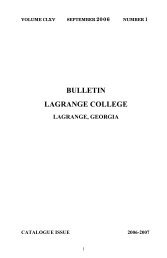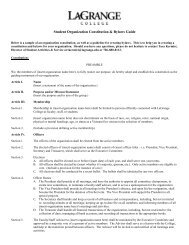The Speed of Light: Historical Perspective and Experimental Findings
The Speed of Light: Historical Perspective and Experimental Findings
The Speed of Light: Historical Perspective and Experimental Findings
You also want an ePaper? Increase the reach of your titles
YUMPU automatically turns print PDFs into web optimized ePapers that Google loves.
TRENT SCARBOROUGH AND BEN WILLIAMSON<br />
wavelength <strong>of</strong> millimeter waves. <strong>The</strong>re was an uncertainty<br />
resulting from the limited wavelength <strong>of</strong> possible radiation,<br />
because the longer wavelengths used in this experiment could<br />
not be measured as accurately as shorter ones. <strong>The</strong> result<br />
achieved from Froome’s work was a value <strong>of</strong> 2.997925 x 10 8<br />
m/s. This result was the best <strong>of</strong> its time as laser technology was<br />
not capable <strong>of</strong> more accurate measurements. 9<br />
Modern Measurements <strong>of</strong> the <strong>Speed</strong> <strong>of</strong> <strong>Light</strong><br />
From 1972 to 1984, many measurements would be made<br />
using the improved technology <strong>of</strong> tungsten-nickel point contact<br />
diodes. <strong>The</strong> new diodes resulted in various speed <strong>of</strong> light measurements<br />
in laser-based experiments, such as Evanson’s 1973<br />
experiment resulting in a speed <strong>of</strong> light value <strong>of</strong> 2.997924574 x<br />
10 8 m/s. This highly accurate result is one <strong>of</strong> the many scientific<br />
benefits <strong>of</strong> stabilized lasers. Before this innovation, emission<br />
radiation from atoms was the only spectrally pure light available<br />
for testing, <strong>and</strong> the frequency <strong>of</strong> such light is difficult to control.<br />
A way <strong>of</strong> locking the frequency <strong>of</strong> the emission was necessary<br />
to accurately measure the speed <strong>of</strong> light by this method, which<br />
was found in the sub-Doppler saturated absorption spectroscopy.<br />
This technique permits the locking <strong>of</strong> frequency <strong>of</strong> the<br />
radiation into a very small window <strong>of</strong> spectral features, so that<br />
both quantities wavelength <strong>and</strong> frequency remain fixed. Since<br />
the development <strong>of</strong> sub-Doppler saturated absorption spectroscopy,<br />
several sources have been stabilized. <strong>The</strong> heliumneon<br />
with a wavelength <strong>of</strong> 3.39 µm (10 -6 m) stabilized with saturated<br />
absorption in methane. Carbon dioxide with a 10 µm<br />
wavelength stabilized to florescence with saturated carbon dioxide.<br />
A red helium-neon source stabilized to iodine-saturated<br />
absorption. <strong>The</strong>se are the three main laser sources used to<br />
measure the speed <strong>of</strong> light, <strong>and</strong> sometimes they are combined.<br />
In the case <strong>of</strong> Fabry-Perot interferometers, two wavelengths<br />
are compared by the observation <strong>of</strong> interference fringes<br />
<strong>of</strong> waves refracting between two mirrors. This has been used to<br />
measure the speed <strong>of</strong> light many times <strong>and</strong> normally using the<br />
st<strong>and</strong>ard-length 605.8 nm (10 -9 m) orange lasers using a krypton<br />
source. Unfortunately, this method results in an error <strong>of</strong><br />
around four parts per hundred million. More accurate measurements<br />
could be made by better measurements <strong>of</strong> emission frequency.<br />
Better results were achieved with techniques using<br />
189


